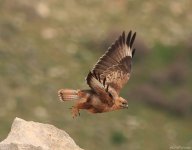Thanks all for the discussion. We still don’t have an agreed name I think. I will ask if he has any other photos.
As hybridization played a major role in its formation, the Atlas Long-legged Buzzards can still technically be called hybrids. I think just that the meaning of hybrids is different before and after 2019. During the last decade, it was thought that these hybrids occur only on the area of the Strait of Gibraltar and northeast Tunisia (and the Strait of Sicily, e.g. at Pantelleria). Also, we thought that these hybridizations may have been more recent. However, the study of Jowers et al (2019) showed that this is not the case (museum samples collected far from the coast decades ago were found out to be a mixture of
rufinus and
buteo genomes).
However, because that study unfortunately
didn’t include samples from one of the main areas where all this started (the Strait of Gibraltar area), I think the picture is still not complete. At the time, I wrote in the blog that this is not a big issue (because “hybrids” found even far south), but I think now it’s probably an issue. The birds in that area have indeed some features not present in “pure”
cirtensis found in the south. Such features include the pale band that run across the under-body. Just a theory, probably these are the results of more recent hybridization with
buteo from the Iberian Peninsula (So old hybridization plus a recent one, I don't know where this will end!). That’s why a friend told me at the time (just after the publication of the cited paper) that another study is underway to fill this gap.
A very red bird, would be at the top end of the spectrum for Steppe?
It's got a very small, almost Kestrel like, head, not sure if that means anything?
I think, it should mean something. That “cute” expression and the small bill,…that got the photographer to wonder about its ID in the first place.
i have a question regarding the sharp cut dark subterminal tailbar. is it a feature of those hybrids, tom? since pure cirtensis usually don't show this vulpinus-like narrow bar. or am i wrong with that?
The bird in plate 34 (in
Rodriguez et al 2013) photographed at Sidi Yahya, way south from the Strait, have this feature. See also the bird in plate 41.
The more you look at it, the more it gets fascinating.







